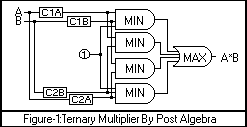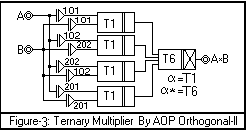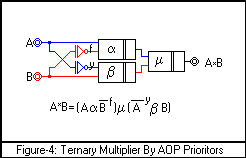|
| |
In this section, I will present a simple design
example to compare between the design using traditional operators and between
AOP operators.
Since, the major operations in our lives are the basic arithmetic operations:
addition, subtraction, division and multiplication, we will provide different designs for
the multiplication operation in ternary system using AOP and Post
algebras and then compare the results.
 1-Example-1:Ternary
Multiplication
Operation Design 1-Example-1:Ternary
Multiplication
Operation Design
 Traditional
Design Traditional
Design
The
function table for the ternary multiplication operation using s-code notation of
AOP is 3S120:210:000.
 Design
Example-1.1: Ternary Multiplier Design using Post Algebra Design
Example-1.1: Ternary Multiplier Design using Post Algebra
|
| Post uses traditional operators MIN, MAX, MV-NOT, C0(x), C1(x) and C2(x).
Using Post notation and its representation of functions, we get the following
"sum-of-products" equation (where: *=Min, +=MAX)
A*B=
[1* C1(A)* C1(B)
]+ [ C1(A)*C2(B) ]+ [ C2(A)* C1(B) ]+ [1* C2(A)*C2(B)
]
|
 |
|
This Post
representation uses 9 binary operators (6 MIN, 3 MAX), and 8 unary operators (complementary
functions). The corresponding circuit for this
equation is shown in Figure-1. The "product-of-sums"
representation uses 15 binary operators (9 MIN, 6 MAX), and 14
unary operators (complementary functions).
|
In the traditional
designs section we presented the design of the ternary multiplication. Let's take
this operation and show its designs using AOP. The
function table for the ternary multiplication operation using s-code notation of
AOP is 3S120:210:000. Before we start, here are AOP operators for
ternary system.
|
 The multi-operations used by AOP in the ternary
system The multi-operations used by AOP in the ternary
system
1.
Conservative unary operators T1, T2, T3, T4, T5 and T6. (see Table-1)
2.
Orthogonal operators: 3W001, 3W002, 3W010, 3W012, 3W020, 3W02 ,3W101, 3W102, 3W110, 3W112, 3W120, 3W121, 3W201, 2W202, 3W210, 3W212, 3W220, 3W221
3.
Prioritors: T1, T2, T3, T4, T5 and T6. (see Table-1)
|
As we see, AOP has a total of 30 operations in
the ternary system: 24 are unary operations (out of 33=27 unary
operations of ternary system) and 6 are
binary operations (out of 332=19,863 binary operations of
ternary system), which are its prioritors. The
traditional binary operators by AOP notations are T1 (MIN), T6 (MAX) and for unary operators are
T1 (MV-NOT) , T6 (identity operator), 3W002 for C0(x),
3W102 for C1(x)
and 3W202 for C2(x).
|

|
 Design
Example-1.2: Design
using AOP Orthogonal Theorem-I Design
Example-1.2: Design
using AOP Orthogonal Theorem-I
|
| The orthogonal
theorem-I is similar in format to Post representations except it is generalized
to cover all the binary and unary operations of AOP. The MRV (most repeated
value) in this table (3S120:210:000) is 0. Thus we select a prioritor whose supremum-digit
is equal to zero. The NMRV (next most repeated value) in this table
(3S120:210:000)
is
1 and 2. Since we have two values for NMRV, we may select a prioritor
with '2' infimum-digit or with '1' infimum-digit. |
The prioritor
with the 1-infimum digit and 0-supremum digit is
T2. Thus, we have a=T2, a ¾ Ù =0, a¾ Ú =1,
a*=T4.
According to this,
one of the best STAS systems to represent this function which will start-off with
the lowest- representation (not minimum) is (T2,T4).
On the other hand, the prioritor
with 0-supremum digit and 2-infimum digit is T1 (MIN).
|
 |
|
Thus,
a =T1, a ¾ Ù =0, a¾ Ú =2,
a*=T6
(MAX). According to this, one of the best STAS systems to represent this function which will start-off with
the lowest-representation (not minimum) is (T1,T6).
Let's just use the
(T1,T6) STAS system. By substituting in orthogonal
theorem-I of AOP we get
A*B= [1a A¾ D102 a B¾ D102]a *[ A¾ D102 a B¾ D202]a *[ A¾ D202 a B¾ D102]a *[1a A¾ D202 a B¾ D202]
using AOP
short notation we get
A*B= [1a A102 a B102]a *[ A102 a B202]a *[ A202 a B102]a *[1a A202 a B202]
Note that this
representation by AOP for this specific example is the same as of Post. It uses
6 T1 (MIN) and 3 T6 (MAX). The corresponding circuit for this equation
is shown in Figure-2 using AOP notations for circuits.

|
|
 Design
Example-1.3: Design
using AOP Orthogonal Theorem-II Design
Example-1.3: Design
using AOP Orthogonal Theorem-II
|
|
We will use the same STAS
system obtained by orthogonal theorem-I, but we substitute in orthogonal
theorem-II to get the following equation:
A*B=[A¾
D101a B¾
D101]a*[A¾
D102a B¾
D202]a*[A¾
D202
aB¾
D102]a*[A¾
D201
a B¾
D201]
using
AOP short-notations we get
A*B=[A101a B101]a*[A102a B202]a*[A202
aB102]a*[A201
a B201]
|
|
 This representation
is different from Post representation and AOP orthogonal-I representation. It
uses 4 T1 (MIN) and 3 T6 (MAX). The corresponding circuit for this equation is shown in
Figure-3. This representation
is different from Post representation and AOP orthogonal-I representation. It
uses 4 T1 (MIN) and 3 T6 (MAX). The corresponding circuit for this equation is shown in
Figure-3.

|
 |
 Design
Example-1.4:
Using AOP multi-operational set of basic operators Design
Example-1.4:
Using AOP multi-operational set of basic operators
If we were to think
of a different circuit for the above example, other than the one provided by
Post
representation, then we would find it is impossible to use the MIN, MAX and MV-NOT to design such a circuit. Even the Post
representation used the complementary functions to get the job done.
|
 Lets use AOP and present
different designs to the same example we started with. Consider the circuit of
Figure-4, which is drawn using AOP symbols for digital circuits. This circuit
contains three prioritors labeled a, b, and m and two conservative unary operators labeled f and
y and it represents the ternary multiplication operation. Lets use AOP and present
different designs to the same example we started with. Consider the circuit of
Figure-4, which is drawn using AOP symbols for digital circuits. This circuit
contains three prioritors labeled a, b, and m and two conservative unary operators labeled f and
y and it represents the ternary multiplication operation.
A*B= (AaB¾f)m
(A¾ ybB)
|

|
 A solution to this circuit, based on AOP multi-operators set, was
carried out and gave 13 distinct circuits. A few are presented in Table-1. A solution to this circuit, based on AOP multi-operators set, was
carried out and gave 13 distinct circuits. A few are presented in Table-1.
In comparison to the previous circuits, this circuit uses
three prioritors (like saying 3 MIN) and two conservative unary operators (like
saying 2 complementary functions or two orthogonal operators).
 Note: This circuit can be reduced
to two binary operators and one unary operator using the virtual
theorems of AOP. Note: This circuit can be reduced
to two binary operators and one unary operator using the virtual
theorems of AOP.
(see TAS
systems) |
 Table-1 Table-1
|
| No |
a
|
b
|
m
|
"f"
|
"Y"
|
|
1
|
T3
|
T3
|
T5
|
T4
|
T4
|
|
2
|
T1
|
T1
|
T2
|
T4
|
T4
|
|
3
|
T1
|
T4
|
T2
|
T4
|
T3
|
|
4
|
T4
|
T1
|
T2
|
T4
|
T4
|
|
5
|
T1
|
T1
|
T6
|
T4
|
T4
|
|
6
|
T1
|
T1
|
T5
|
T4
|
T4
|
|
7
|
T4
|
T1
|
T2
|
T3
|
T4
|
 Decision Making: Decision Making:
If we have to select one design from the aforementioned four examples,
which one will we choose? From an engineering point of view, will use the
design of Example-1.4 by AOP because it is less complex, has low power
consumption, has less propagation delay, has higher in speed, and uses les chip space
than the other designs.
From a managerial point of view, we will choose the
design of Example-1.4 by AOP because it is
more economical in terms of cost. The Post design used used 9 binary operations
8 unary operators while the circuit of Example-1.4 (Figure-4) used three binary
operators and two unary operators. This difference
represents 66% reduction in cost of binary operations and 62.5% reduction in
cost of ternary operations.
Let's take a few of the solutions as
shown in Table-1 above and discus them. In 1-11 entry, we can
use T3, and T5 prioritors and T4 conservative operator. Entry 2-1 shows another
configuration. It uses T1 and T2 prioritors and T4 conservative operator. This
entry shows how T2 and T4 cooperate with the traditional operator T1 to
get the job done. The same can be said for the other entries.
 It is impossible to design this circuit of Figure-4 using the traditional operators of Post. Thus, an
engineer who relies on Post representations and has a solid faith in its
operators will never come up with such a circuit and will have only the circuit
we obtained in design, example-1 which is more complex. It is impossible to design this circuit of Figure-4 using the traditional operators of Post. Thus, an
engineer who relies on Post representations and has a solid faith in its
operators will never come up with such a circuit and will have only the circuit
we obtained in design, example-1 which is more complex.

|
 2-Example-2: Design of 3S201:001:111 2-Example-2: Design of 3S201:001:111
Assume we
are given a two-variable function with a function table given by s-code as
3S201:001:111. First we will represent the function using Post and then using
AOP.
 Design
Example-2.1: Design
of Ternary Operation Shown in Table below Design
Example-2.1: Design
of Ternary Operation Shown in Table below
|
| Assume we
are given a two-variable function F(A,B) as shown. Using Post notation we get the following
representation (sum-of-products) F(A,B)= [1* C0(A)* C0(B)
]+ [1* C0(A)* C1(B) ]+ [1* C0(A)* C2(B)
]+ [1* C1(A)* C0(B) ]+ [1* C2(A)* C0(B)
]+ [C2(A)* C2(B) ] This representation uses
16 binary operations (11 MIN and 5 MAX) and 12
unary operations.
|
| A~B |
0 |
1 |
2 |
| 0 |
1 |
1 |
1 |
| 1 |
1 |
0 |
0 |
| 2 |
1 |
0 |
2 |
|
|
 If we use the product-of sums we get the
followings: F(A,B)= [1+ J0(A)+ J0(B)
]* [1+ J0(A)+ J1(B) ]* [1+ J0(A)+J2(B)
]* [1+ J1(A)+J0(B) ]* [J1(A)+ J1(B)
]* [J1(A)+ J2(B) ]*[1+J2(A)+ J0(B) ]*[J2(A)+
J1(B) ] If we use the product-of sums we get the
followings: F(A,B)= [1+ J0(A)+ J0(B)
]* [1+ J0(A)+ J1(B) ]* [1+ J0(A)+J2(B)
]* [1+ J1(A)+J0(B) ]* [J1(A)+ J1(B)
]* [J1(A)+ J2(B) ]*[1+J2(A)+ J0(B) ]*[J2(A)+
J1(B) ]
This product-of-sums representation uses 20 binary operations (13 MAX and 7 MIN) and 16 unary
operations.
|
 Design
Example-2.2:Using
Orthogonal theorem-I Design
Example-2.2:Using
Orthogonal theorem-I
For any function, Post
algebra has no choices except to represent the function by MIN, MAX and
complementary functions. But this is different in AOP. Since AOP has
multiple operations, it does the followings: it searches for the best STAS set
of prioritors and then uses its orthogonal theorems to represent the
function. In ternary multiplication design, AOP selected (T1,T6) and
(T2,T4) as the best STAS systems and we went on and used (T1,T6) for comparison
reasons with Post. But note the difference in this example, here AOP
selects one STAS system based on the function to be represented.
The MRV (most
repeated value) in the function table (3S201:001:111) of this function is
1, thus we select a prioritor whose supremum-digit is equal to one. The
NMRV (next most repeated value) in this table is 0, thus we select a
prioritor with an infimum-digit equal to 0. The prioritor with 1-supremum
digit and 0-infimum digit is T4. Thus a =T4, a ¾ Ù =1
a¾ Ú =0, and
a*=T2. The best STAS system to represent this function
which will start-off with the lowest representation (not minimum) is (T4,T2). By
substituting in AOP orthogonal theorem-I we get:
F(A,B)= [0aA¾ D110aB¾ D110]a*[0aA¾ D110aB¾ D210]a[0aA¾ D210aB¾ D110]a[2aA¾ D210 aB¾ D210]
Since 0 is the infimum digit of a , then using the infimum-theorem, we modify the first
three terms and get
F(A,B)= [A¾ D110 a B¾
D110]a*[A¾ D110
a B¾ D210]a*[A¾ D210
a B¾ D110]a*[2a A¾ D 210aB¾ D 210]
using AOP
short-notations we get
F(A,B)= [A110 a B110]a*[A110 a B210]a*[A210 a B110]a*[2a A210aB210]
This representation
uses 5 T4s, 3 T3s, and 8 orthogonal operators. That is a total of 8 prioritors
(8 binary operations) and 8 orthogonal operators. However, the Post
representation for the same function by sum-of-products used 16 binary operations and 12
complementary functions and by product-of-sums it used 20 binary operations and 16 unary
operations. The difference between the representations of AOP
and Post is 8
binary operations plus 4 unary operations for sum-of-products and 12 binary operation
plus 8 unary operations for product-of-sums representation. This shows the expressive power of AOP over
Post. Thus, by no sense at all we can
say that AOP is equivalent to Post.

 Design
Example-2.3:Using
Orthogonal theorem-II Design
Example-2.3:Using
Orthogonal theorem-II
We use the same STAS system obtained by
orthogonal theorem-I, but we substitute in orthogonal theorem-II to get the
following.
F(A,B)= [A¾ D110a B¾ D110]a*[A¾ D110 a B¾ D210]a*[A¾ D210 a B¾ D110]a*[A¾ D212 a B¾ D212]
using
AOP short-notations we get
F(A,B)= [A110a B110]a*[A110 a B210]a*[A210 a B110]a*[A212 a B212]
This representation uses 4 T4s and 3 T2s. That
is a total of 7 binary operations and 8 orthogonal operators.

 Design
Example-2.4:
Smart Design
Using AOP multi-operational set of basic operators Design
Example-2.4:
Smart Design
Using AOP multi-operational set of basic operators
Using the multi-operational set of
AOP, we can design this example by 3 binary operations and 2 unary
operations. A solution to this example, based on AOP multi-operators set, was
carried out and gave 142 solutions. For example,
we can design
this example by using two T3's and T2 prioritors and three T5 conservative
operators (solution#14).
Thus AOP equation for this example is f(A,B)=(AaB¾f)m(A¾fmB¾f)
where a=T2, m=T3 and f=T5. This shows how AOP reduces circuit
complexity of MVL circuits. Using the Image-Scaling theorem of AOP (a
theorem in AOP that replaces DeMorgan's Laws), we
can go further and reduce the number of conservative operators and get f(A,B)= (AaB¾f)m(AbB)¾fwhere b=T1.
Compare this design (3 binary operations & 2 unary operations) to Post
representations (16 binary operations & 12 unary operations)!!!!!!
 Summary: Summary:
In the design of Example-2.1, we used the fundamental connectives of Post and obtained the given ternary operation as a composition of the basic connectives. What we got
is a circuit with 16 binary operations and 12 unary operations for the
sum-of-products representation and 20 binary operations and 16 unary operations
for the product-of-sums. In the design of Example 2.2, we used the orthogonal theorem-I of AOP and its basic operators and
we got 8 binary operations and 8 unary operations. In the design of Example
2.3, we used the orthogonal
theorem-II of AOP and its basic operators and got a simpler circuit than the
previous two designs with 7 binary operations and 8 unary operations. In the
design of Example 2.42, we used 3 binary
operations and 2 unary operations.
 This shows that
use of the new operators provides circuits that are more simpler and more efficient than
use of the traditional operators. This shows that
use of the new operators provides circuits that are more simpler and more efficient than
use of the traditional operators.

|
